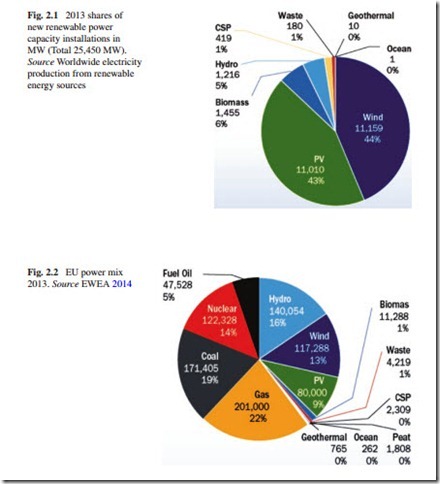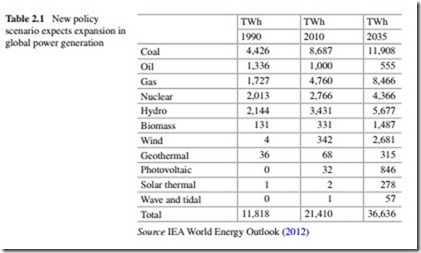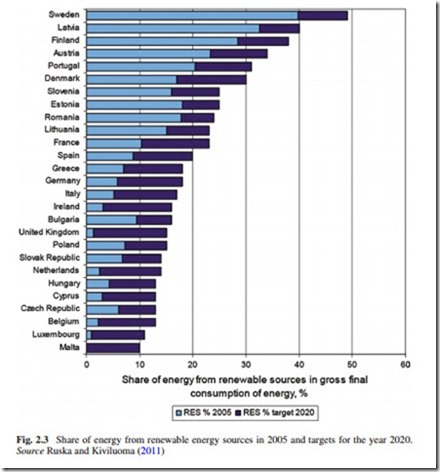Abstract Deployment of renewable energy sources has been increasing rapidly in recent years. Various types of government policies, the declining cost of many renewable energy technologies, changes in the prices of fossil fuels, an increase in energy demand, among other factors, have encouraged the continuing increase in the use of renewable energy sources for the generation of electricity in several countries from all regions. Despite global financial challenges, renewable energy capacity continued to grow rapidly compared to the cumulative installed capacity from the previous year. In 2013, a total of 25.4 GW of new renewable power capacity was installed. Over 72 % of all new installed capacity in the EU were renewable. It is important to highlight that renewable energy sources are expected to be economically competitive with conventional energy sources for electricity generation in the medium to long-term.
Introduction
Deployment of renewable energy sources has been increasing rapidly in recent years. Various types of government policies, the declining cost of many renewable energy technologies, changes in the prices of fossil fuels, an increase in energy demand, among other factors, have encouraged the continuing increase in the use of renewable energy sources for the generation of electricity in several countries from all regions. Despite global financial challenges, renewable energy capacity continued to grow rapidly compared to the cumulative installed capacity from the previous year.
In 2013, a total of 25.4 GW of new renewable power capacity was installed. Over 72 % of all new installed capacity in the EU were renewables (see Fig. 2.1). It was, furthermore, the sixth year running that over 55 % of all new power capacity in the EU were renewable (Worldwide Electricity Production from Renewable Energy Sources 2013).
The major increases were registered in wind power with 44 %, followed by solar photovoltaic with 43 %, biomass with 6 % and hydropower with 5 %. The EU energy mix in 2013 is shown in Fig. 2.2. According to that figure, natural gas had the major share with 22 % of the total, followed by coal with 19 %, hydro- power with 16 %, nuclear energy with 14 %, wind power with 13 % and solar photovoltaic with 9 %.
The use of decentralized renewable energy (excluding traditional biomass) in meeting rural energy needs of the household or village level has also increased, including hydropower plants, various modern biomass options, solar PV, and wind or hybrid systems that combine multiple technologies.
The development of renewable energy sources, particularly energy from wind, hydro, solar, geothermal, hydrogen, and biomass is a central aim of the European Commission’s Energy Policy.1 There are several reasons for that:
• The use of renewable energy sources for electricity generation has an important role to play in reducing CO2 emissions;
• Increasing the share of renewable energy sources in the European energy balance enhances sustainability;
• Helps to improve the security of energy supply by reducing the growing dependence of the region on imported fossil fuels.
Undoubtedly, the exploitation of renewable energy sources will help the EU to meet many of its environmental and energy policy goals, including its obligation to reduce greenhouse gases under the Kyoto Protocol (EC 2002a), and the aim of securing its energy supply (EC 2002b, 2005). Despite the reduction in electricity demand renewable energy source deployment has continued during the past years. This is a result of various national support schemes—in particular for solar PV and wind onshore—but also of constant technological improvement, decreasing prices (in the case of solar PV also due to a supply surplus) and greater supplier competition, which have all led to successful cost reductions. According to the EC, the EU is on track to meet its 2020 renewables target. But in 2012 some parties also voiced doubts because the current economic crisis could oblige some EU member states to downsize their renewables policies and thus jeopardize the implementation of their NREAPs approved by the EC.
Renewable energy sources are expected to be economically competitive with conventional energy sources for electricity generation in the medium to long- term. It is important to highlight that renewable energy resources are not only expected to be economically competitive in the near future, but it is an abundant energy source around the world. If this statement is true, then, why many countries have not already switched from fossil fuels to renewables for electricity generation? The main reason is the following: Many countries are deeply dependent on the use of fossil fuels, and consequently, significant barriers exist to mainstreaming renewable energy use. According to the United Nations sources:
• Fossil fuels (coal, oil, and gas) account for 80 % of global energy consumption;
• Total energy sales worldwide amount to about US$1 trillion per year (3 % global GDP);
• Fossil fuel subsidies are about US$150 billion per year;
• New renewable sales are about US$20 billion per year.
While solar and wind power were growing at 20 % and 30 % respectively in the past years and their costs are decreasing rapidly, their market share is minuscule compared to the scale of oil and gas production. The technical potential for solar energy is the highest among the different renewable energy sources, but substantial technical potential exists for all types of renewables. Even in regions with rela- tively low levels of the technical potential for any individual renewable energy source, there are typically significant opportunities for increased deployment com- pared to current levels. In the longer term and at higher deployment levels, how- ever, technical potentials indicate a limit to the contribution of some individual renewable energy technologies. Factors such as sustainability concerns, public acceptance, system integration and infrastructure constraints or economic factors may limit deployment of renewable energy technologies in some regions during the coming years (IPCC 2012).
According to Table 2.1, coal will be the energy source that will produce the majority level of electricity by 2035 followed by natural gas, hydropower, nuclear energy and wind.
The EU has ambitious targets in the field of environment and energy policy. According to the EEA Technical Report No 6/2009 (2009), the new climate-energy legislative package sets mandatory national target corresponding to a 20 % share of renewable energies in overall EU energy consumption by 2020, and a mandatory 10 % minimum target to be achieved by all EU member states for the share of renewable energy in transport consumption by 2020. A significant part of the new renewable energy sources capacity will be wind power and solar PV; Germany, Spain and Italy are the leading countries in the use of these types of renewables for the generation of electricity. However, it is important to highlight that the output of these electricity production forms is variable, and not dispatchable in the traditional sense, and this characteristic is limiting the expansion in the use of these two renewable energy sources for the generation of electricity in other European countries.
It has been estimated, that the renewable energy sources share in electricity sector would be around 35 % in 2020, if the 20 % target for renewable energy sources is achieved. In the EU, renewables accounted for almost 70 % of the additions to electric capacity in 2012, mostly from solar PV and wind power. In 2011, renewables met 20.6 % of the region’s electricity consumption and 13.4 % of gross final energy consumption.2 Renewables made up just over half of total net additions to electric generating capacity from all sources in 2012. By year’s end, they comprised more than 26 % of global generating capacity and supplied an estimated 21.7 % of global electricity, with 16.5 % of electricity provided by hydropower. Industrial, commercial, and residential consumers are increasingly becoming producers of renewable power in a growing number of countries (REN 21 2013).
On the other hand, increasing wind and solar PV generation presents vast challenges in the power market and electricity grids. The keys to integrate varia- ble generation into the grid are adequately interconnected electricity markets and smarter grids with more flexible demand (Ruska and Kiviluoma 2011). The 2009 directive on the promotion of the use of energy from renewable energy sources (2009/28/EC) drafted a trajectory on how to reach the targets adopted by the EC for all EU member states. Because each EU member state has different renew- able energy potential and energy mix, targets vary between them. EC directive adopted on this subject improves the legal framework for promoting renewable electricity, requires national action plans that establish pathways for the development of renewable energy sources, creates cooperation mechanisms to help achieve the targets cost effectively and establishes the sustainability criteria for biofuels.
Figure 2.3 shows the share of energy from renewable sources in gross final consumption of energy. The countries with the highest percentage are Sweden, Latvia, Finland and Austria.
In the EU, the satisfaction of energy needs is crucially linked to the security of energy supply and commitments to reduce greenhouse gas emissions to the atmos- phere. The development of distributed generation and renewable electricity generation technologies are essential to achieve these goals. In the long-term, Europe has a vision of a sustainable energy system where hydrogen and electricity act as the two main energy forms with fuel-cell technology providing the bridge between them. Together, these interchangeable energy carriers provide a unique pathway to gradually decreasing Europe’s dependence on fossil fuels, and reducing green- house gas emissions and pollutants.


